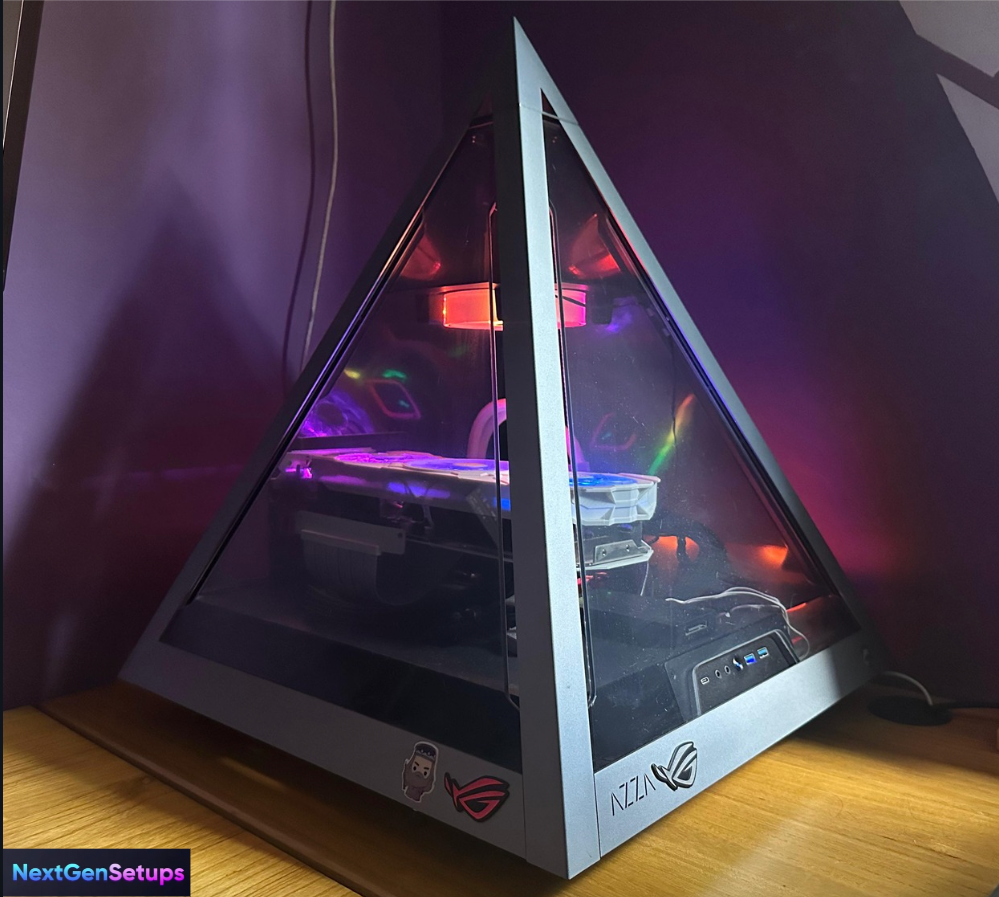
If you’ve ever dreamed of owning a gaming setup that looks like it belongs in a sci-fi movie set, you’ve probably stumbled upon the AZZA Pyramid PC Case. It’s one of those rare, show-stopping designs that leaves your friends asking, “What the hell is that?!”
After more than a year of daily use and a few demanding rebuilds, I can confidently share everything you need to know about this pyramid-shaped computer case. From unboxing, building quirks, and thermal performance to compatibility with modern 2025 components, this guide covers it all.
Let’s dive in.
To Sum It Up
At first glance, the AZZA Pyramid PC Case looks nothing like your traditional rectangular tower. It’s a four-sided pyramid-shaped pc case constructed from gray anodized aluminum with tempered glass panels on every face, offering a 360-degree view of your build.
Designed to be both functional and artistic, the AZZA 804L blurs the line between gaming hardware and modern furniture. It’s not a gimmick either — this case offers respectable airflow, decent component compatibility, and plenty of opportunities for builders looking to show off their high-end parts.
Since its release, it has been one of the few pyramid pc towers available, sharing space with models like the AZZA 804V and the CSAZ 804L Pyramid Innovative ATX Case. Among enthusiasts, it’s affectionately called the gaming pc pyramid or computer case pyramid.
Pros
Cons
AZZA Pyramid 804L Specifications
Before you think about this case, it’s crucial to know what it can (and can’t) accommodate. Here’s a detailed breakdown:
| Specification | Details |
|---|---|
| Type | ATX Pyramid Enclosure |
| Color | Gray anodized aluminum (exterior) / Black (interior) |
| Side Panels | 4 x Tempered glass |
| Max CPU Cooler Height | Up to 95 mm |
| Max Video Card Length | 330 mm (L) x 150 mm (W) x 70 mm (H) (Horizontal orientation) |
| Motherboard Compatibility | E-ATX (less than 305 x 280 mm), ATX, Micro ATX, ITX |
| 2.5″ Drive Bays | Up to 2 |
| 3.5″ Drive Bays | Up to 1 |
| Expansion Slots | 3 |
| I/O Ports | Power button, HD audio, 2 x USB 3.0, 1 x USB-C |
| Case Dimensions (H x W x D) | 585 mm x 490 mm x 490 mm |
| Weight | 14.1 kg / 31.1 lbs |
| Available Fan Ports | 1 x 120 mm (top), 5 x 120 mm (bottom) |
| Included Fan | 1 x 120 mm AZZA Hurricane III ARGB Fan |
| Water Cooling Support | Radiators up to 360 mm (bottom right mount) |
| Power Supply | Bottom mounted ATX power supply |
| Included Accessories | 200 mm PCI-e 3.0 Riser Cable |
AZZA Pyramid 804L Key Features Overview
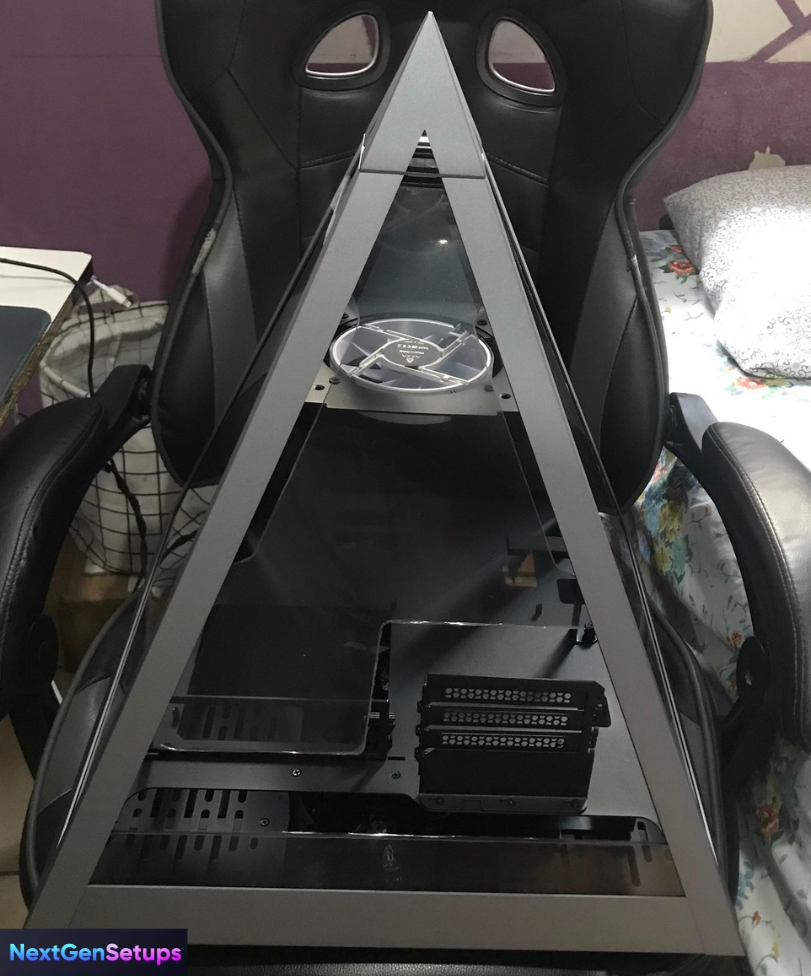
The AZZA Pyramid PC Case isn’t just about flashy looks. Underneath its striking pyramid shape, it’s a surprisingly capable chassis:
- Tempered glass panels provide panoramic views of your hardware.
- Supports full ATX motherboards (within size limits) — rare for cases this unconventional.
- Includes a PCIe 3.0 riser cable so your GPU mounts horizontally in the pyramid’s center.
- Supports liquid cooling radiators up to 360 mm — a must-have for high-performance setups.
- Bundles a 120 mm AZZA Hurricane III ARGB fan for exhaust at the pyramid’s apex.
- Well-designed bottom intake setup with up to five 120 mm fan mounts.
It’s not all perfect, though — and that’s where my personal build experience comes in.
My Build Experience with the AZZA Pyramid PC Case
Unboxing & First Impressions
The AZZA Pyramid 804L arrives in a relatively modest cardboard box. Pro tip: get a second person to help. At nearly 31 lbs and a bulky shape, it’s a handful to maneuver solo. Inside, you’ll find the case, tempered glass panels, screws, the PCIe riser (Black color), a black GPU bracket and a small manual.
The packaging is secure, but unpacking the case and panels carefully is essential to avoid smudges or scratches. Find below the original box and the first look once you open the box.
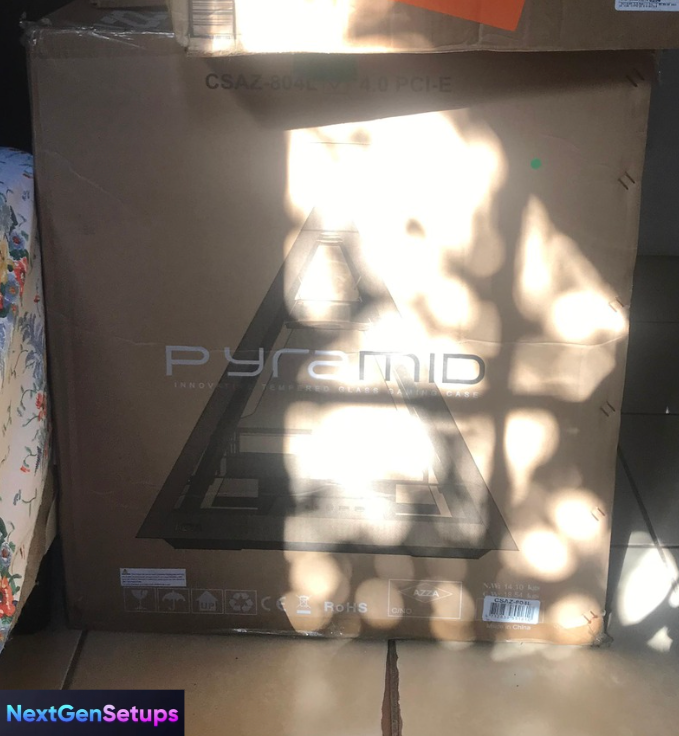
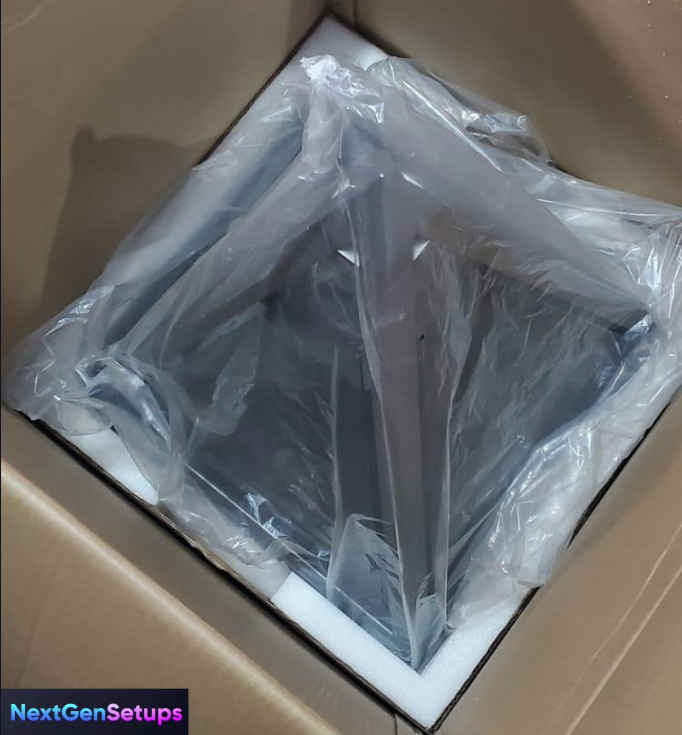
Component Compatibility
My build featured:
- Intel Core i9 12th Gen processor ( → Check on Amazon )
- Nvidia 4070 TI
- Mini ATX motherboard
- Liquid cooling setup (If you are not a fan of a liquid cooling system, you can consider the Noctua NH-D15 as an option)
While I initially worried whether an ATX board and 4070 TI would fit, it did. Just keep in mind the max GPU length limit of 330 mm. If you’re eyeing a 4080 or future 50 series cards, measure twice.
Also — note that the PCIe riser cable included is black. I’m a sucker for white-themed builds, so I picked up a white riser separately.
Assembly & Cable Management
This case is not beginner-friendly. Cable management, component placement, and airflow planning demand attention. The pyramid shape means cables run upwards and diagonally. It’s tight, but everything has a place if you’re patient.
The Mini ATX motherboard made things easier, but full ATX boards within the size limits will fit.
Cooling Performance and Thermal Management
Despite its closed pyramid structure, the AZZA Pyramid 804L performs better than you’d expect.
The included 120 mm Hurricane III ARGB fan at the top does a solid job of exhausting hot air. I paired it with three 120 mm fans at the bottom intake and a 360 mm radiator mounted bottom-right for liquid cooling.
Note: The case also has extra space on the bottom left if you want to add more fans, but honestly, I’ve found them unnecessary. With a good liquid cooling setup and the stock AZZA Hurricane III fan doing its job at the top, temperatures have stayed solid in my build. Unless you’re planning to push your system with extreme overclocks or live in a particularly hot environment, the default airflow setup works just fine.
I’ve tested this Pyramid computer tower in Lumion renders and games at ultra settings, the case stayed remarkably cool:
- GPU rarely hit above 72°C
- CPU hovered around 65°C under load
Surprisingly, the pyramid layout promotes natural heat rise toward the top exhaust fan.
Build Quality, Design, and Materials
This case is pure premium — thick aluminum panels, solid frame, 4 mm tempered glass, and smooth finishing. Every screw, bracket, and hinge feels sturdy.
Even after over a year of moving, rebuilding, and cleaning, no rattles or warped panels. AZZA delivered exceptional build quality, fitting of the $400+ price tag.
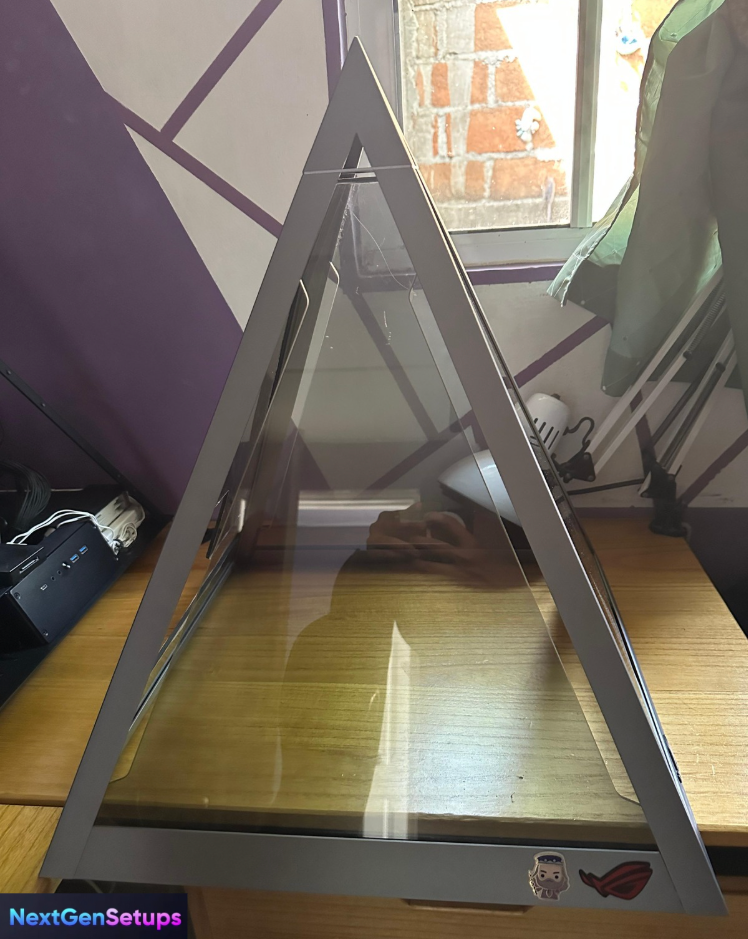
Compatibility and Assembly Tips
Critical Dimensions:
- Max GPU length: 330 mm
- Max CPU cooler height: 95 mm
- Radiator support: 360 mm at bottom right
Pro Builder Tips:
- Go for a Mini ATX motherboard unless you’re 100% certain your ATX board fits with your chosen GPU.
- Measure GPU dimensions carefully — not all modern GPUs play nicely with the pyramid’s clearance.
- Cable management requires pre-planning due to angled routing.
- If aesthetics matter, replace the included black PCIe riser with a colored one of your choice.
- Install components outside the frame when possible — then mount as units.
Up next, I’ve added a special section where I walk you through exactly how I built this pyramid desktop case. Keep reading — you might pick up a few helpful tips for your own build!
Is It Worth It for Different Types of Builders?
The AZZA Pyramid 804L isn’t for everyone — and that’s part of its charm. Here’s a quick breakdown of whether this case makes sense for you:
Hardcore Gamers:
Yes, if you want a standout setup.
Thermals are solid with a good liquid cooling setup, and you can run a 40 series or 50 series card (under 330 mm) with no issues.
PC Modding Enthusiasts:
Absolutely.
The case’s modular internals, PCIe riser mount, and four glass panels make it a dream for RGB builds and custom loops.
First-Time Builders:
Not recommended.
Between tight cable routing, heavy panels, and a non-traditional layout, it’s better suited for experienced builders. (But I built this one with 0 experience so go for it)
Office/Workstation Users:
No, unless aesthetics matter.
You can find better airflow and storage options in a standard ATX tower for professional workflows.
Showcase or Museum-Style Rigs:
Perfect.
If you’re building a rig for a LAN event, store display, or your own gaming lounge centerpiece, it’s unbeatable.
Step-by-Step: How I Built My AZZA Pyramid 804L

If you’re considering tackling a build inside the AZZA Pyramid 804L, be prepared: it’s not your typical mid-tower assembly. Thanks to its inverted pyramid layout and tight internal space, there’s a specific order that’ll save you both headaches and time.
Here’s exactly how I did it — step-by-step.
Step 1: Prepping the Power Supply
Important tip:
Due to limited access once the power supply is mounted, connect all necessary cables to your PSU before installation.
This includes:
- 24-pin motherboard power
- 8-pin CPU power
- PCIe GPU power cables
- SATA/power cables for drives
With everything plugged in, carefully route the cables upward through the strategically placed openings in the frame. This will make connecting them to other components much easier later on.
Step 2: Install the Motherboard (with CPU and Storage Pre-Installed)
Before mounting the motherboard, install:
- Your CPU
- RAM modules
- M.2 NVMe SSD (if applicable)
Once the board is prepped, carefully lower it into the pyramid and screw it into position.
Pro tip:
Because of the layout, you may find it easier to plug in some front panel connectors and cables before fully tightening the board down.
Step 3: Install Liquid Cooling (If Using One)
If you’re going for a liquid-cooled setup like I did:
- Install the radiator at the bottom right mount first.
- Then carefully run the cooling tubes up through the side cutouts.
It’s tight, but manageable. Connect the block to your CPU before routing your hoses for the cleanest setup.
Important:
Do this before adding the GPU, or you’ll run out of maneuvering space.
Step 4: Manage and Route Cables
At this stage, go ahead and connect:
- 24-pin ATX
- 8-pin CPU
- SATA power (if used)
- Case I/O cables (USB, audio, power button)
Use the pyramid’s side cutouts to route cables cleanly. Cable management here takes some creativity, but AZZA provides a few anchor points and channels.
Step 5: Install the PCIe Riser Cable
Attach the PCIe 3.0 / 4.0 riser cable to your motherboard’s primary PCIe x16 slot. Secure the riser bracket in its mounting slot on the GPU platform inside the case.
If you plan on using a color-custom riser like I did, swap it now before moving on.
Step 6: Install the Graphics Card
With the riser in place:
- Mount your GPU horizontally on the riser bracket
- Connect your PCIe power cables
Note:
Remember that maximum GPU length is 330 mm. Larger cards won’t allow the top pyramid panel to close properly. The current option I am using for this setup is the GALAX GTX 4070 TI, some other GPU options that can be consider are ASUS Dual GeForce RTX™ 4060 or the PNY GeForce RTX™ 5070 ARGB (Check on Amazon)
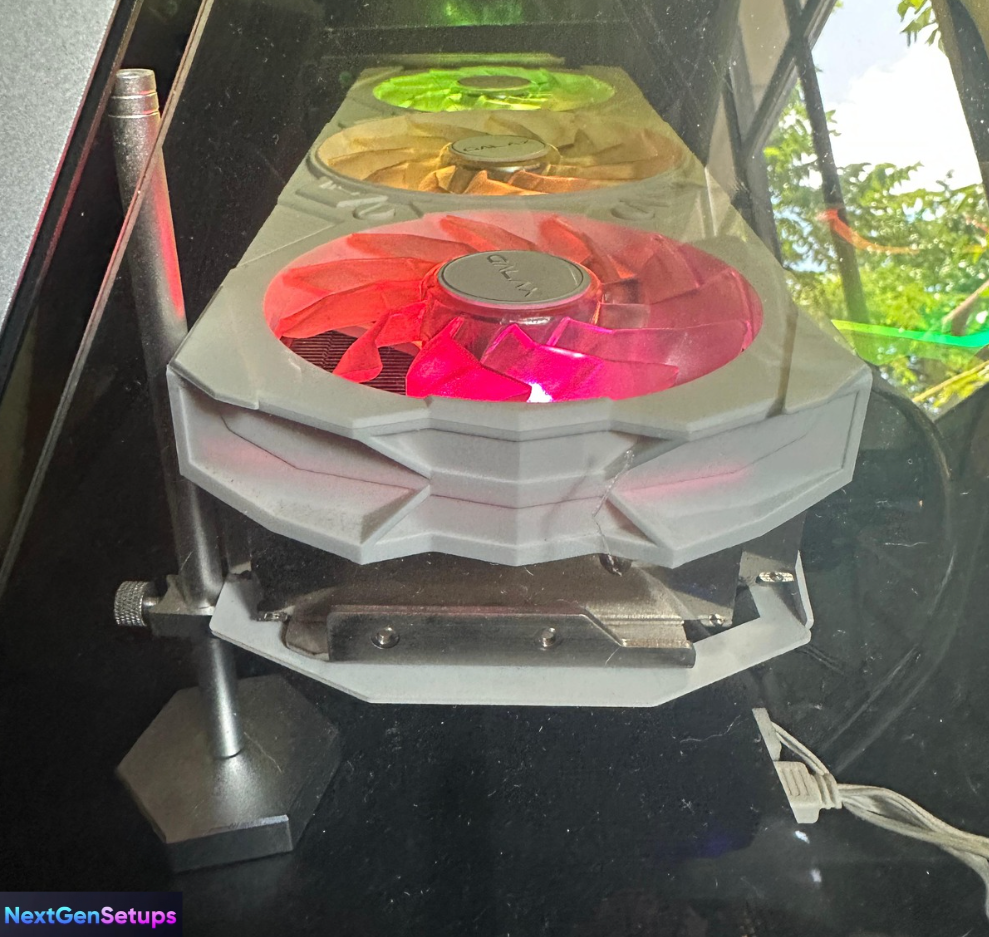
Step 7: Final Cable Routing and Clean-Up
Now that all your core components are installed:
- Tidy up your cabling
- Double-check all power connections
- Test-fit the tempered glass panels to ensure no cables obstruct closing
Use zip ties or Velcro straps to secure loose cables. Keep airflow pathways clear — especially the bottom intake zone and top exhaust area.
Step 8: Install Included Fan(s) and Additional Cooling (If Needed)
The AZZA Pyramid 804L comes with a 120 mm AZZA Hurricane III ARGB fan pre-installed at the top.
I added three intake fans at the bottom for extra airflow, plus my 360 mm radiator.
Use the provided mounts and brackets to secure everything neatly.
Step 9: Power On and Final Fit Test
Before sealing it up:
- Run a power-on test
- Confirm POST success, fan operation, and RGB lighting
- Check cable clearances against the glass panels
If everything checks out, install your four tempered glass panel structure, secure them with the included thumb screws, turn it on and enjoy your new pyramid gaming PC case masterpiece.
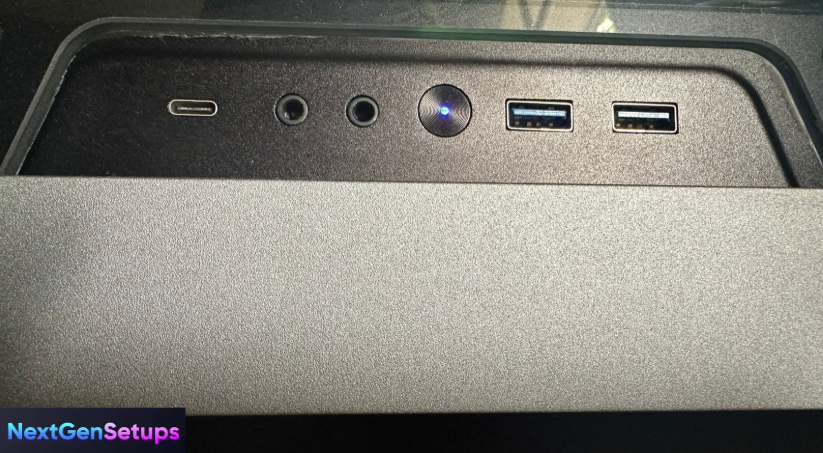
If you are builing a unique setup you shoud check this fututistic Keyboard: GravaStar Mercury K1
How I Clean and Maintain My AZZA Pyramid 804L
Because the AZZA Pyramid 804L features an open-frame design with multiple cutouts and ventilation openings along its sides and base, it’s naturally more exposed to dust than traditional enclosed cases. The open airflow concept, while great for thermals, means dust and fine debris can easily settle on internal components and fans. For this reason, it’s important to establish a regular maintenance routine to keep the build clean, preserve airflow efficiency, and maintain the premium look that makes this case so special.
In my case, I’ve gotten into the habit of giving the AZZA Pyramid 804L a good cleaning every three and six months. Every three months or so, I’ll wipe down the glass panels (because fingerprints and dust are constant), and pop off the top section to check inside. You’d be surprised how quickly dust builds up around the AZZA Hurricane III fan, the GPU, around the motherboard and especially around the radiator if you’re running liquid cooling like I am.
A quick clean-out keeps everything looking sharp and running properly, for this I use a Handheld Car Vacuum Cleaner with the brush suction nuzzle equiped. (See what model I am using on Amazon: JONYJ Handheld Car Vacuum)
Then, twice a year, I go a little deeper. That’s when I check the liquid cooling system, clean out the radiator fins, and make sure there’s no weird buildup or airflow blockage anywhere. It might sound like overkill, but with daily use and some long gaming and rendering sessions, it really helps keep temps stable and the system running smoothly. Plus, it keeps the build looking showcase-ready — which, let’s be honest, is half the reason for owning a case like this. It’s a little bit of effort, but totally worth it for how good it makes the rig look and perform over time.
Is the AZZA Pyramid PC Case Worth It in 2025?
If you’re building a pyramid gaming pc case for performance and aesthetics — yes. This case delivers both.
However, if you’re after pure functionality, ease of build, or budget-friendly options, you’ll find better choices in conventional ATX cases.
This is a luxury, showcase piece for enthusiasts who appreciate premium materials and want a setup no one else has.
Final Thoughts: Would I Buy the AZZA Pyramid 804L Again?
After over a year with it, I would. The azza pyramid computer case transformed my setup from “cool” to jaw-dropping centerpiece.
Despite its quirks, tight spaces, and premium price, it delivered both thermal performance and visual impact.
If you’re chasing something beyond ordinary — the AZZA Pyramid 804L delivers.
Frequently Asked Questions (FAQ) About Pyramid AZZA 804L
Will a RTX 4080 or RTX 50 series GPU fit inside the AZZA Pyramid 804L?
Possibly, if under 330 mm long. Measure carefully.
Does the PC case pyramid shape cause overheating?
No. In fact, the upward airflow is surprisingly effective with a proper fan setup.
Can you use a full ATX motherboard?
Yes — as long as it’s under 305 x 280 mm.
Is this case good for gaming builds?
Absolutely. It handled Lumion and extreme settings gaming for me flawlessly.
Is the PCIe riser cable included PCIe 4.0?
No — the stock riser is PCIe 3.0. If you’re using a PCIe 4.0 GPU and motherboard, upgrading the riser is recommended.
Does this case support liquid cooling?
Yes — it supports radiators up to 360 mm on the bottom right, ideal for AIO or custom loops.
Can you mount the power supply easily?
Yes — it mounts at the base of the case, but routing cables upward requires extra care due to the inverted layout
Is cable management difficult in a pyramid PC case?
Yes. Due to the unique internal layout and angled design, managing cables takes careful planning. It’s not beginner-friendly.
The Future of Pyramid PC Cases
Pyramid-shaped cases aren’t mainstream yet — but the growing trend of aesthetic-focused builds, glass showcases, and vertical mounting means we might see more variations in the future.
Concept brands and boutique modders continue to experiment with oddball form factors. While AZZA leads the charge, other niche manufacturers could step in, especially as compact ATX and ITX pyramid cases become more viable with modern component miniaturization.
Would I like to see a Pyramid 805 or AZZA Pyramid Mesh Edition? Absolutely.
Best Alternatives to the AZZA Pyramid 804L
While the AZZA Pyramid PC Case remains the king of pyramid-shaped designs, there are a few alternatives worth considering if you’re craving unique enclosures or can’t source the 804L.
KEDIERS Diamond Pyramid ATX PC Case
A fresh contender in the pyramid case space, the KEDIERS Diamond Pyramid ATX offers a striking geometric design with tempered glass panels and RGB lighting. It supports ATX, Micro ATX, and Mini ITX motherboards and comes with several pre-installed RGB fans. While slightly more budget-friendly than the AZZA, it still delivers serious showcase vibes for those wanting a statement piece on their desk.
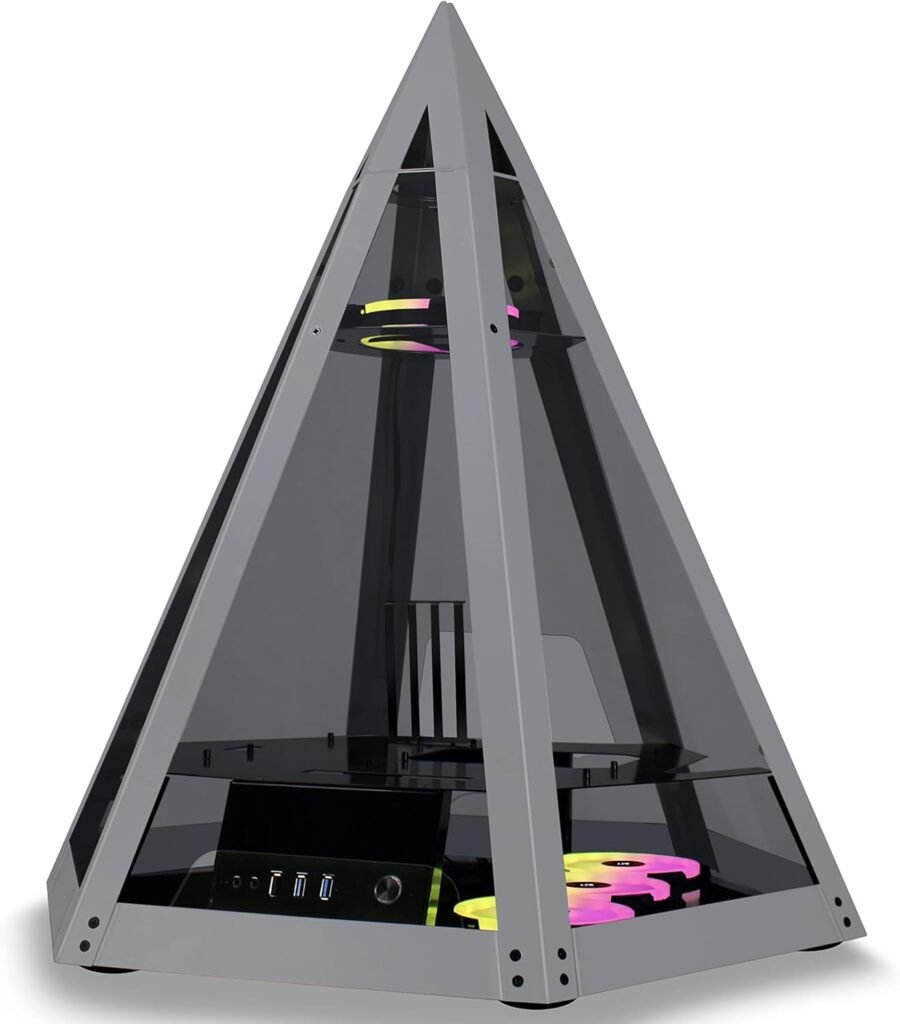
AZZA Regis 902
While it’s not a pyramid shape, the AZZA Regis 902 takes the same design-first philosophy with its cube-like form and an infinity mirror front panel that looks phenomenal in any RGB build. It supports E-ATX motherboards, offers excellent airflow, and is perfect if you like avant-garde PC cases but prefer a more practical layout than the 804L.
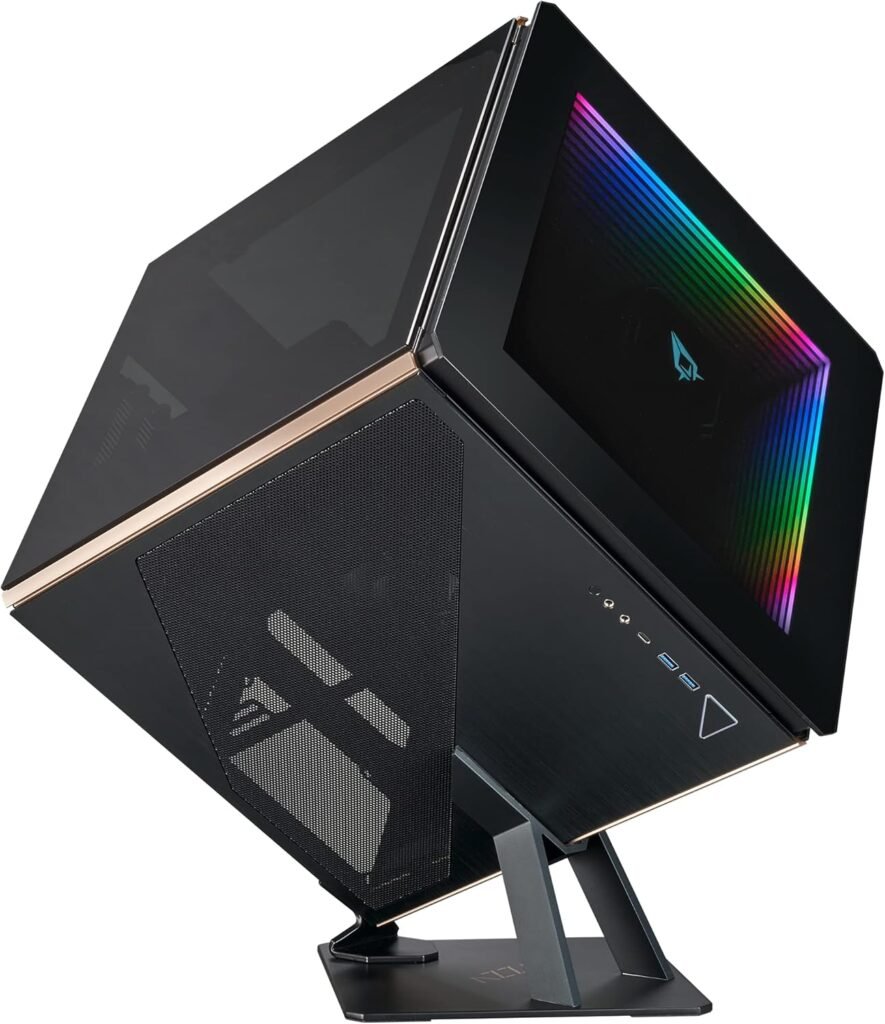
AZZA CSAZ-812 Diamond
Another bold option from AZZA, the CSAZ-812 Diamond sports an aggressive polygonal diamond-shaped design, complete with tempered glass panels and a customizable RGB setup. It supports ATX, Micro ATX, and Mini ITX boards and comes with multiple pre-installed fans. This case is a solid middle ground between the Pyramid and Regis, offering standout visuals without sacrificing too much internal space or cable management ease.
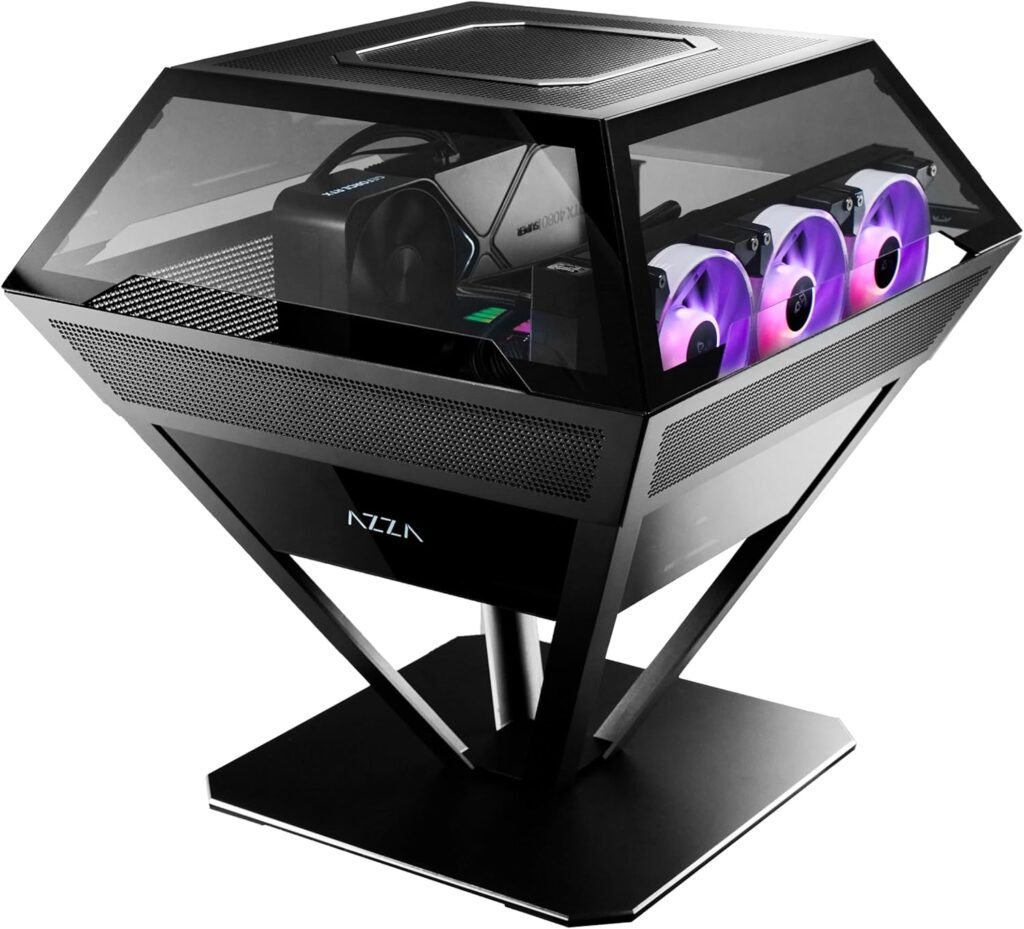
Prebuilt Pyramid PC Systems
Some boutique builders offer pyramid pc prebuilts — systems assembled and tuned inside AZZA 804L/804V cases. Great for those who want the look without the build hassle.
If none of these scratch your aesthetic itch, you can sometimes find modders on Reddit or PC building forums crafting custom pyramid tower pcs out of acrylic, metal, and tempered glass.
If you’re in the market for a showpiece gaming case that breaks away from traditional towers, these three options — alongside the AZZA Pyramid 804L — should be at the top of your list. Each offers unique styling, premium materials, and room for creative builds that will absolutely turn heads.

Noah Blackburn
WriterI’m Noah Blackburn, a gaming enthusiast and home office aficionado. I love getting my hands on the latest tech, rigorously testing everything from gaming keyboards to productivity monitors. My passion is sharing my detailed experiences in posts, highlighting performance, comfort, and real-world utility. I aim to help others make smart choices for their ultimate gaming setup or efficient home workspace.
